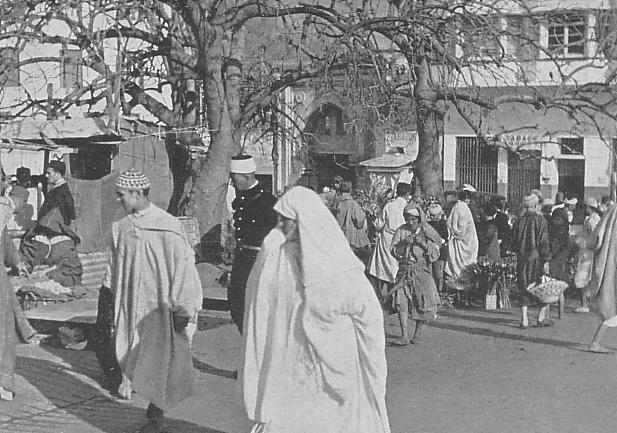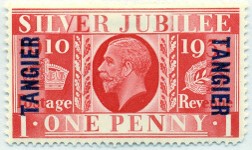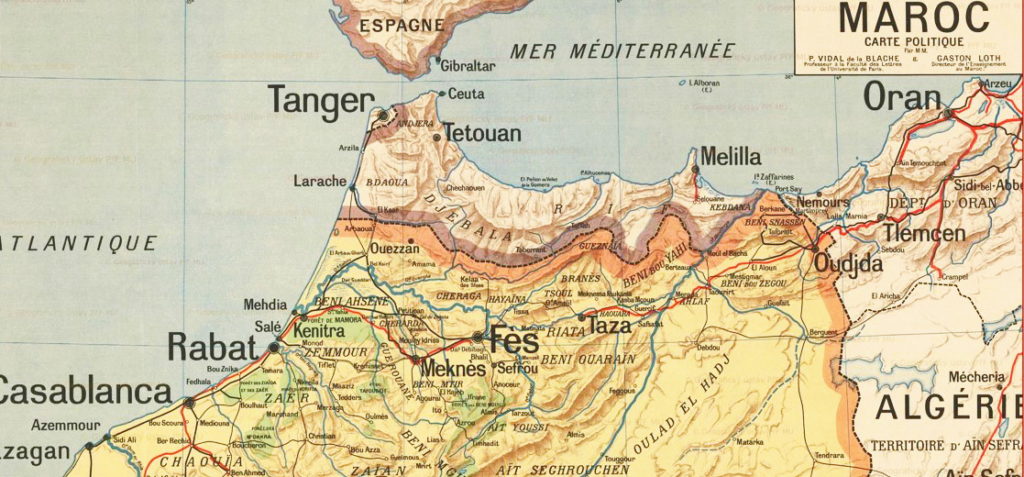ALBUM – International Zone of Tangier, British Offices
Summary
The International Zone of Tangier, located on the northwest coast of Morocco, was administered by a committee of foreign powers from 1924 – 1956. When Spain and France divided Morocco for colonization in 1912, Tangier remained a disputed area, primarily because of it’s strategic location at the mouth of the Mediterranean Sea. As a result, it was decided that Tangier would become an International Zone. The agreement was put on hold due to World War I, and wasn’t finalized until Dec 18, 1923 in the Tangier Protocol. With the exception of Spanish Occupation during World War II, Tangier remained an international zone until it became part of the newly created Kingdom of Morocco in 1956. Great Britain, like France and Spain, maintained a post office in Tangier throughout its existence.
Fast Facts
Region: North Africa
Group: International Zone
Classification: Foreign Post Offices
Prior Regime: Sultanate of Morocco
Key Dates:
1912, Nov – Spain and France divides Morocco into separate protectorates
1923, Dec 18 – Tangier Protocol signed
1924, May 14 – Tangier officially becomes an International Zone
1940, Jun 14 – Spanish Troops occupy Tangier
1945, Oct 11 – Tangier returns to International Zone status
1956, Oct 29 – Tangier incorporated into the Kingdom of Morocco
Following Regime: Kingdom of Morocco
First Stamp Issued: 1927
Scott Catalogue: Great Britain, Offices Abroad, Morocco (501-611)
Pick Catalogue: No specific banknotes were issued for the International Zone of Morocco
Currency: various international currencies were used
History of the International Zone of Tangier

In the Scramble for Africa, European powers carved up the continent of Africa for colonization. While the French laid claim to most of North and Western Africa, Spain received a few territories along the Atlantic coast. Even after the 1884 Berlin Conference, Morocco remained a disputed area, especially in the north, as the British didn’t want any other European powers to control the land across from Gibraltar.
A side agreement was finally reached in 1904, where Spain and France could carve up Morocco with British agreement. However, the Germans were furious that they weren’t involved in the negotiation. This situation prompted Kaiser Wilhelm II to visit Tangier on March 31, 1905, where he gave a speech calling for Moroccan independence. This was a direct challenge to French influence in the region, setting up the first Moroccan Crisis.
Over the next few years the Great Powers postured and Germany and France became bitter rivals. Eventually most nations sided with France (except Austria-Hungry) and in 1912. The Sultan Morocco was forced to divide the country between France and Spain, becoming their protectorates. Thus, Morocco became the last territory in Africa to be colonized. Tangier, however, would be designated as a joint protectorate administered by France, Spain and Great Britain.
The outbreak of WWI complicated the agreement, and the final implementation of the international status wasn’t officially ratified until 1923. Over time, additional countries were added to the agreement as administering powers, including the Netherlands, Belgium, Sweden, Portugal, and Italy.
During WW2, Spanish troops occupied Tangier on Jun 14, 1940, the day that Paris fell to the Germans. Italy, being an Axis country, was dropped as an administrator. After the war, Spanish troops withdrew from Tangier on Oct 11, 1945 and the United States and the USSR were added as administrators while Italy was re-instated.
During much of its existence, the International Zone of Tangier was a haven for spies, smugglers, free thinkers, artists and those seeking a hedonistic lifestyle. Also during the the time, Great Britain, Spain and France had active post offices in the city.
In 1956, Tangier became part of the newly independent Kingdom of Morocco.
Stamps
 ALBUM
ALBUM
The first British post office established in Morocco opened in Tangier in 1857. For 50 years, mail was transported to Gibraltar for franking and handling, although Tangier got its own postmark in 1872. Beginning in 1907, the British took direct control of Post offices in Morocco.
After the establishment of the Tangier International Zone, Great Britain begin overprinting stamps “TANGIER” in 1927 for issue at their post office in the city. No surcharge was needed, as British currency was used in the office.
The following series were overprinted for use in the zone:
- 1927 – King George V definitive issues
- 1934-35 – King George photogravure set of definitive issues
- 1935, May 8 – Silver Jubilee issues
- 1936, Oct 25 – King Edward VIII definitive issues
- 1937, May 13 – King George VI Coronation issues
- 1937 – King George VI – definitive issues
- 1940, May 6 – Stamp Centenary issues
- 1944/1949 – King George VI definitive issues
- 1946, Jun 11 – Victory Commemorative issues
- 1948, Apr 25 – Silver Wedding Anniversary issues
- 1948, Jul 29 – Olympic Games issues
- 1949, Oct 10 – UPU Centenary issues
- 1951 – King George VI definitive issues in new colors and new designs of Schilling values
- 1952-54 – Queen Elizabeth definitive issues (Tudor Crown E2R watermark)
- 1953, Jun 1 – Queen Elizabeth Coronation issues
- 1955, Sep 23 – Queen Elizabeth definitive issues (St Edward’s crown E2R watermark)
- 1957, Apr 1 – Queen Elizabeth definitive issues (St Edward’s crown E2R watermark) overprinted “1857-1957”
The British post office in Tangier closed on Apr 30, 1957. Prior to the closing, on Apr 1, 1957, the overprint “1857-1957” was added to stamps sold at the office to commemorate the 100th anniversary of the post office in Tangier. One month later, the office closed and stamps withdrawn from sale.
As a note – beginning Aug 23, 1950, any overprinted British stamp, which did not alter the face value, was allowed to be used within the UK. Therefore, Morocco Agencies and Tangier stamps with UK postmarks are not uncommon.
Banknotes
As an International Zone, no specific currency was issued for Tangier. However, during World War II, Spain occupied Tangier from 1940-1945, and during that period issued a series of notes in 1941/2 for use during the occupation.
Links
History of Morocco – Wikipedia
Tangier – Encyclopaedia Britannica
The First Moroccan Crisis (1905) – The History Channel
The Second Moroccan Crisis (1911) – the History Channel
British Post offices in Morocco – Wikipedia
Tangier Overprints – GB Overprints Society





